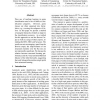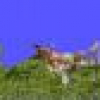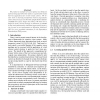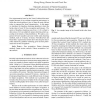2056 search results - page 203 / 412 » Learning Visual Invariance |
CONNECTION
2006
13 years 8 months ago
2006
By learning a range of possible times over which the effect of an action can take place, a robot can reason more effectively about causal and contingent relationships in the world...
ACL
2010
13 years 6 months ago
2010
Prior use of machine learning in genre classification used a list of labels as classification categories. However, genre classes are often organised into hierarchies, e.g., coveri...
CVPR
2008
IEEE
14 years 10 months ago
2008
IEEE
Objects in the world can be arranged into a hierarchy based on their semantic meaning (e.g. organism ? animal ? feline ? cat). What about defining a hierarchy based on the visual ...
ICPR
2004
IEEE
14 years 9 months ago
2004
IEEE
We present an example of a joint spatial and temporal task learning algorithm that results in a generative model that has applications for on-line visual control. We review work o...
ICIP
2008
IEEE
14 years 2 months ago
2008
IEEE
Face representation based on the Visual Codebook becomes popular because of its excellent recognition performance, in which the critical problem is how to learn the most efficien...




